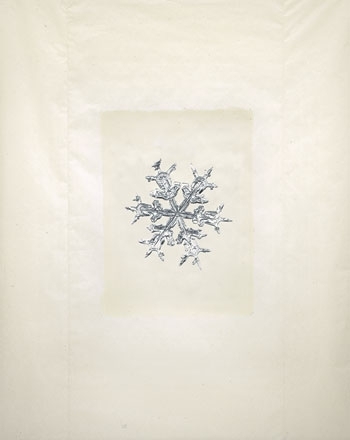Art Now: Doug and Mike Starn
–
For immediate release: 11/14/08
For further information contact: Emmie Donadio, (802) 443–2240
Middlebury, VT—On Tues., Jan. 6 the Middlebury College Museum of Art opens the exhibition Art Now: Doug and Mike Starn. Consisting of enlarged photomicrographs of snowflakes and the museum’s newly acquired, many-layered photographic image of a tree, this new installation will remain on view through Sun., Apr. 19. It marks the continuation of the museum’s series of shows devoted to contemporary art.
Born in 1961, Doug and Mike Starn are identical twins whose artistic practice has from the beginning been a collaboration. Graduates of the School of the Museum of Fine Arts, Boston, they first garnered widespread national attention in the Whitney Museum of American Art Biennial of 1987, showing photographs that challenged the prevailing practice of museum installation. Their large-scale works comprised many sheets of photographic paper stuck together with Scotch Tape and pins and placed directly on a wall. Addressing a religious subject, the “Stretched Christ” in particular (a photographic image based on Phillipe de Champaigne’s painting The Dead Christ) was provocative in all its aspects.
An insistent experimental attitude toward materials and display gives rise to the Starns’s aesthetic strategy, which highlights the inherent transience and fragility of art, and of the photographic medium in particular. Working in a wide range of formats—sculpture, video, painting, and installation art—the brothers use photography as the basis for image making, and they have explored myriad techniques for fixing their subjects on a permanent surface. Their work often depicts organisms that undergo metamorphic transformation—moths and leaves, for instance—and they have recently devised an apparatus with a refrigerated flat plate that keeps snowflakes frozen until their unique forms can be captured through a microscopic lens. This body of work was conceived in Vermont and pays homage to “Snowflake” Bentley (1835-1931), the Jericho, Vermont, photographer whose pioneering excursions in photographic microscopy are responsible for our recognition that no two snowflakes are alike.

Doug and Mike Starn, Sno8_215 (blanket), 2005-2008, archival ink on gampi paper with acrylic paint and varnish, 64 x 50 inches. © 2008 Mike + Doug Starn/Artists Rights Society (ARS), New York/HackelBury Fine Arts (London, UK)
The image of a tree that the museum has acquired belongs to a series of works the artists have named “Structure of Thought.” This image is related to the Starns’s commission for New York’s South Ferry subway terminus, scheduled for inauguration this winter. At that site—an installation more than 250 feet in length, with heights varying from 9 to 14 feet—the artists have used photographs as templates for layered, fused glass tiles depicting trees and leaves. “Structure of Thought” refers to the parallels the artists have perceived between the branching structure of trees and the arrangement of microscopic dendrites of neurons in the brain. In their conception, the layering of imagery in this photographic series serves as a metaphor for the overlapping, complex pathways of thought and illumination that, taken together, define each of us—the amalgamated record of where we have been and what we have noticed and recalled: the sum of all of our experience.
In a similar way, the snowflake images on view, from a series the Starns have named “alleverythingthatisyou,” may be regarded as visual equivalents of the singularity and uniqueness of each individual. “Simple and complex,” the artists write, “[snow crystals] are all the same and all are different, hexagonal crystals growing outward in branches from their six-sided molecule of H20.”
As the Starns have written, “the mind is an interpreter of constantly fed information. Your mind decodes and understands information based on a lifetime of constructions, memories, desires, and learning. Vision doesn’t work like a camera; vision is a construction. The structure of thought is a living dendritic mess, a mass of intersections and layers.”
The Middlebury College Museum of Art, located in the Kevin P. Mahaney ’84 Center for the Arts on Rte. 30 on the southern edge of campus, is free and open to the public Tues. through Fri. from 10 a.m. to 5 p.m., and Sat. and Sun. from noon to 5 p.m. It is closed Mondays. The museum is accessible to people with varying disabilities. Parking is available in the Center for the Arts parking lot. For further information, please call (802) 443–5007 or TTY (802) 443–3155, or visit the Museum’s website at museum.middlebury.edu.
